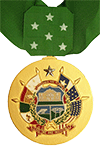Jack joined eight of his men from Troop F, another thirteen from other units of Second Squadron, and forty-one from the remainder of the 124th Cavalry in graves on a hillside near the scene of the “Battle of Knight’s Hill”. The plot was enclosed by a bamboo fence and overlooked a valley of rice paddies. Four years later his remains were moved to another valley half way around the world, a small cemetery near the family church, Holder’s Chapel Methodist Church. The day was notable for the bone chilling cold of a midwinter blue norther, blizzards that occasionally sweep through North Texas with gale force winds. Jack’s sacrifice on Loi Kang Ridge has not been forgotten through the intervening years. Following is a list of some of the honors that have come his way:
The VFW Post in Mineral Wells was named in his honor.
A street in Fort Wolters was given his name.
Mamma was named Gold Star Mother of Texas.
The 112th Cavalry National Guard Regiment established a unit trophy for excellent performance in his name, to be presented each year. On October 14, 1972, Admiral of the Fleet, the Earl Mountbatten of Burma dedicated a monument for Troop F, 124th Cavalry in Mineral Wells, during which he praised both Jack and Curtis.
In 1991, a Texas Historical marker was placed at his grave in the Holder’s Chapel cemetery.
In October 1993, June and I attended a ceremony at Southmost College in Brownsville, Texas, to dedicate a historical marker for Jack, who had served at the the site of the college when it was Fort Brown.
On May 31, 1999, June and I were in Austin to receive, on behalf of Jack, the Texas Legislative Medal of Honor, the second one to be presented. Governor George W. Bush made the presentation to June.
In 2000, another historical marker was placed at the entrance to what had been Fort Wolters to honor both Jack and Audie Murphy, both of whom passed through the facility, and were the only ones to receive the Medal of Honor.
At Fort Benning, Georgia, July 5, 2005, Jack was inducted into the Army Ranger Hall of Fame.




